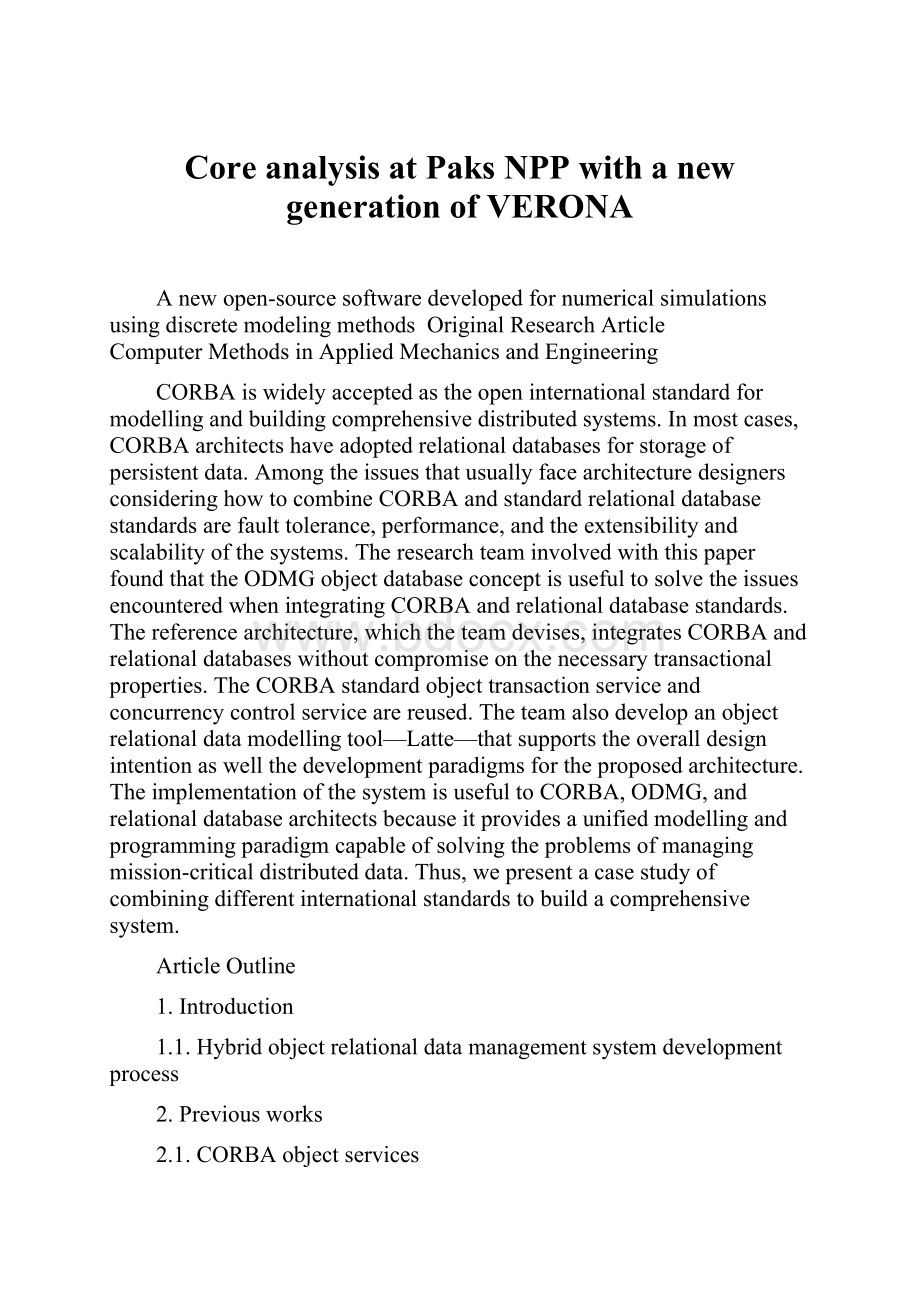Core analysis at Paks NPP with a new generation of VERONA.docx
《Core analysis at Paks NPP with a new generation of VERONA.docx》由会员分享,可在线阅读,更多相关《Core analysis at Paks NPP with a new generation of VERONA.docx(14页珍藏版)》请在冰豆网上搜索。

CoreanalysisatPaksNPPwithanewgenerationofVERONA
Anewopen-sourcesoftwaredevelopedfornumericalsimulationsusingdiscretemodelingmethods OriginalResearchArticle
ComputerMethodsinAppliedMechanicsandEngineering
CORBAiswidelyacceptedastheopeninternationalstandardformodellingandbuildingcomprehensivedistributedsystems.Inmostcases,CORBAarchitectshaveadoptedrelationaldatabasesforstorageofpersistentdata.AmongtheissuesthatusuallyfacearchitecturedesignersconsideringhowtocombineCORBAandstandardrelationaldatabasestandardsarefaulttolerance,performance,andtheextensibilityandscalabilityofthesystems.TheresearchteaminvolvedwiththispaperfoundthattheODMGobjectdatabaseconceptisusefultosolvetheissuesencounteredwhenintegratingCORBAandrelationaldatabasestandards.Thereferencearchitecture,whichtheteamdevises,integratesCORBAandrelationaldatabaseswithoutcompromiseonthenecessarytransactionalproperties.TheCORBAstandardobjecttransactionserviceandconcurrencycontrolservicearereused.Theteamalsodevelopanobjectrelationaldatamodellingtool—Latte—thatsupportstheoveralldesignintentionaswellthedevelopmentparadigmsfortheproposedarchitecture.TheimplementationofthesystemisusefultoCORBA,ODMG,andrelationaldatabasearchitectsbecauseitprovidesaunifiedmodellingandprogrammingparadigmcapableofsolvingtheproblemsofmanagingmission-criticaldistributeddata.Thus,wepresentacasestudyofcombiningdifferentinternationalstandardstobuildacomprehensivesystem.
ArticleOutline
1.Introduction
1.1.Hybridobjectrelationaldatamanagementsystemdevelopmentprocess
2.Previousworks
2.1.CORBAobjectservices
2.2.WOO-DBJavabinding
2.3.Distributedobject-baseddatabasearchitecturemodel
2.4.CORBA/OODBintegration
3.Systemmodeldesign
3.1.Three-tiermodel
3.2.Datamodel
3.3.Transactionmodel
3.4.Failuremodel
4.Systemarchitecturedesign
4.1.Systemoverview
4.2.Systemarchitecture
4.2.1.Latte
4.2.2.ROcomponents
4.2.2.1.ROServer
4.2.2.2.RO
4.2.2.3.ROFactory
4.2.2.4.ROManager
4.3.Interactionsoftransactionalprograms
5.Issuesandconstraints
5.1.Criticalissues
5.1.1.ROServerrecovery
5.1.2.Keys
5.1.3.Datamodificationpropagation
5.1.4.Multi-inheritance
5.2.Systemconstraints
5.2.1.Transactions
5.2.2.Workingtogetherwithlegacyapplications
5.3.Systemperformance
5.3.1.Retrieval
5.3.2.Update
5.3.3.Discussiononimprovements
6.Concludingremark—aggregatingstandards
References
CSHM:
Web-basedsafetyandhealthmonitoringsystemforconstructionmanagement OriginalResearchArticle
JournalofSafetyResearch
Thepurposeofthisworkistopresentthedevelopmentofanopen-sourcesoftwarebasedonadiscretedescriptionofmatterappliedtostudythebehaviorofgeomaterials.ThissoftwareusesObjectOrientedProgrammingtechniques,anditsmethodologydesignusesthreedifferentmethods,whicharetheDiscreteElementMethod(DEM)[F.Donzé,S.A.Magnier,Formulationofathree-dimensionalnumericalmodelofbrittlebehavior,Geophys.J.Int.122(1995)790–802,F.Donzé,S.A.Magnier,L.Daudeville,C.Mariotti,Numericalstudyofcompressivebehaviourofconcreteathighstrainrates,J.Engrg.Mech.(1999)1154–1163],theFiniteElementMethod(FEM)[J.Rousseau,E.Frangin,P.Marin,L.Daudeville,Discreteelementmodellingofconcretestructuresandcouplingwithafiniteelementmodel,Comput.Concrete(inprint),S.P.Xiao,T.Belytschko,Abridgingdomainmethodforcouplingcontinuawithmoleculardynamics,Comput.MethodsAppl.Mech.Engrg.193(2004)1645–1669]andtheLatticeGeometricalMethod(LGM)[J.Kozicki,Applicationofdiscretemodelstodescribethefractureprocessinbrittlematerials,Ph.D.thesis,GdańskUniversityofTechnology,2007,J.Kozicki,J.Tejchman,2Dlatticemodelforfractureinbrittlematerials,Arch.Hydro-Engrg.Environ.Mech.53
(2)(2006)71–88,J.Kozicki,J.Tejchman,Effectofaggregatestructureonfractureprocessinconcreteusing2Dlatticemodel,Arch.Mech.59(4–5)(2007)365–384,J.Kozicki,J.Tejchman,Modellingoffractureprocessinconcreteusinganovellatticemodel,Granul.Matter(inprint),doi:
10.1007/s10035-008-0104-4].Thesemethodsareimplementedwithinasingleobject-orientedframeworkinC++usingOOPdesignpatterns.ThebulkoftheoriginalworkconsistedmainlyoffindingcommonobjectswhichwillworkforthesedifferentmodelingmethodswithoutchangingasinglelineoftheC++code.Withthisapproachitispossibletoaddnewnumericalmodelsbyonlyplugging-inthecorrespondingformulas.TheadvantagesoftheresultingYADEframeworkarethefollowing:
(1)genericdesignprovidesgreatflexibilitywhenaddingnewscientificsimulationcode,
(2)numeroussimulationmethodscanbecoupledwithinthesameframeworklikeforexampleDEM/FEMand(3)withtheopen-sourcephilosophy,thecommunityofuserscollaborateandimprovethesoftware.TheYADEframeworkisanewemergingsoftware,whichcanbedownloadedatthewebpage.
ArticleOutline
1.Introduction
2.Overviewofsimulationmethods
2.1.DiscreteElementMethod
2.2.LatticeGeometricalModel
2.3.CouplingtheDiscreteElementMethodwiththeFiniteElementMethod
3.Introducingtheobjectorientedarchitecture
3.1.TheUMLnotation
3.2.Languagechoice
3.3.Genericprogrammingapproach
3.4.Objectorienteddesignpatterns
4.Constructingtheframework
5.Commonobjectsunderlyingscientificsimulation
5.1.Dataclasses
5.2.Engineclasses
5.3.Simulationoverview
6.ApplicationoftheYADEframework
6.1.DiscreteElementMethod
6.2.LatticeGeometricalModel
6.3.CouplingtheDiscreteElementMethodwiththeFiniteElementMethod
7.Conclusions
Structuredmodelinggroupsupportsystems:
aproductdesigntheory OriginalResearchArticle
Information&Management
Structuredmodelingiscriticaltothedesign,development,andimplementationofmanysystemsincludingcomputersoftware,businessprocesses,anddatanetworks.Sincethecreationofstructuredmodelsreliesontheknowledgeofmanyorganizationalstakeholders,groupsoftenaccomplishthistask.Groupsupportsystems(GSS)focusonthesupportofgroupprocessesandwouldappeartobeusefulforstructuredmodeling;however,GSSusuallyonlyprovidetextualordecisionrelatedoutputratherthanthestructuredmodelsneededformanydesignprocesses.Thispaperproposesaclassofsystems,structuredmodelingGSS(smGSS),whichaddssupportforthedevelopmentofstructuredmodelstostandardGSS.Sincepastresearchhasshownthatresearchresultsmaybedifficulttocompareacrossstudieswhenthesystemunderinvestigationisnotwelldefined,thispaperdevelopsaproductdesigntheorythatdefinestherequiredcharacteristicsofandtestabledesignpropositionsforansmGSSasderivedfromexistingtheoryandempiricalinvestigations.
ArticleOutline
1.Introduction
2.Structuredmodelingandcollaboration
3.AnISdesigntheoryapproach
4.AproductdesigntheoryforansmGSS
4.1.Designproductkerneltheories
4.1.1.Group
4.1.2.Task
4.1.3.Context
4.1.4.Technology
4.1.5.Process
4.1.6.Outcomes
4.2.Meta-requirementsforansmGSS
4.2.1.Boundaries
4.2.2.Propositions
4.2.3.Meta-requirements
4.3.Meta-design
4.4.Testabledesignproducthypotheses
5.Conclusion
References
Vitae
IntegrationofCORBAandobjectrelationaldatabases OriginalResearchArticle
ComputerStandards&Interfaces
IPODLAS—Asoftwarearchitectureforcouplingtemporalsimulationsystems,VR,andGIS OriginalResearchArticle
ISPRSJournalofPhotogrammetryandRemoteSensing
Environmentalprocessesoftenvaryinspaceandtimeandactoverseveralscales.Currentsoftwareapplicationsdealingwithaspectsoftheseprocessesemphasizepropertiesspecifictotheirdomainandtendtoneglectotherissues.Forexample,GISprefersastaticviewandgenerallylackstherepresentationofdynamics,temporalsimulationsystemsemphasizethetemporalcomponentbutignorespacetoagreatextent,andvirtualrealitytendsto“forget”theunderlyingdataandmodels.Inordertoremedythissituationwepresentanapproachthataimstobringtogetherthethreedomains;temporalsimulationsystems,GIS,andvirtualreality,andtofostertheintegrationofparticularfunctionalities.ThispaperconcentratesonconceptsandrequirementsforthedevelopmentofasuitablesoftwarearchitectureusingcasestudiesandusecasesseenfromaGIS-basedperspective.
ArticleOutline
1.Introductionandmotivation
1.1.‘IPODLAS’—couplingTSS,GIS,andVR
1.2.Objectives
2.IssuesofcombinationofGIS,VR,andTSS
2.1.GISfunctionalityused
2.2.Integrationstrategy
2.3.Interoperabilityinitiatives
3.Methodsandmaterials
3.1.Unifiedsoftwaredevelopmentprocess
3.2.Constraintsandenablers
3.2.1.Casestudiesandusecases
3.2.2.Legacysystems
3.2.3.Standards,policies,andlanguages
4.Identifyingtherequiredfunctionality—theIPODLASapproach
4.1.Casestudies
4.2.Usecases
4.3.Listingandclassifyingtherequiredfunctionality
4.4.UsecaseLBMexpert2(LE2)
5.Softwarearchitecture
5.1.Developmentofthesoftwarearchitecture
5.1.1.The‘intelligenttree’
5.1.2.Cross-implementation
5.1.3.Socketcommunication
5.2.Currentsoftwarearchitecture
5.2.1.Dataexchange
5.2.2.GML3—temporalaspects
6.Discussion
6.1.TheIPODLASapproach
6.2.Softwarearchitecture
6.3.CouplingTSS,GIS,andVR
6.4.GML
6.5.Lessonslearned
7.Conclusionandoutlook
Acknowledgements
References
Analgorithmicframeworkforconvexmixedintegernonlinearprograms OriginalResearchA